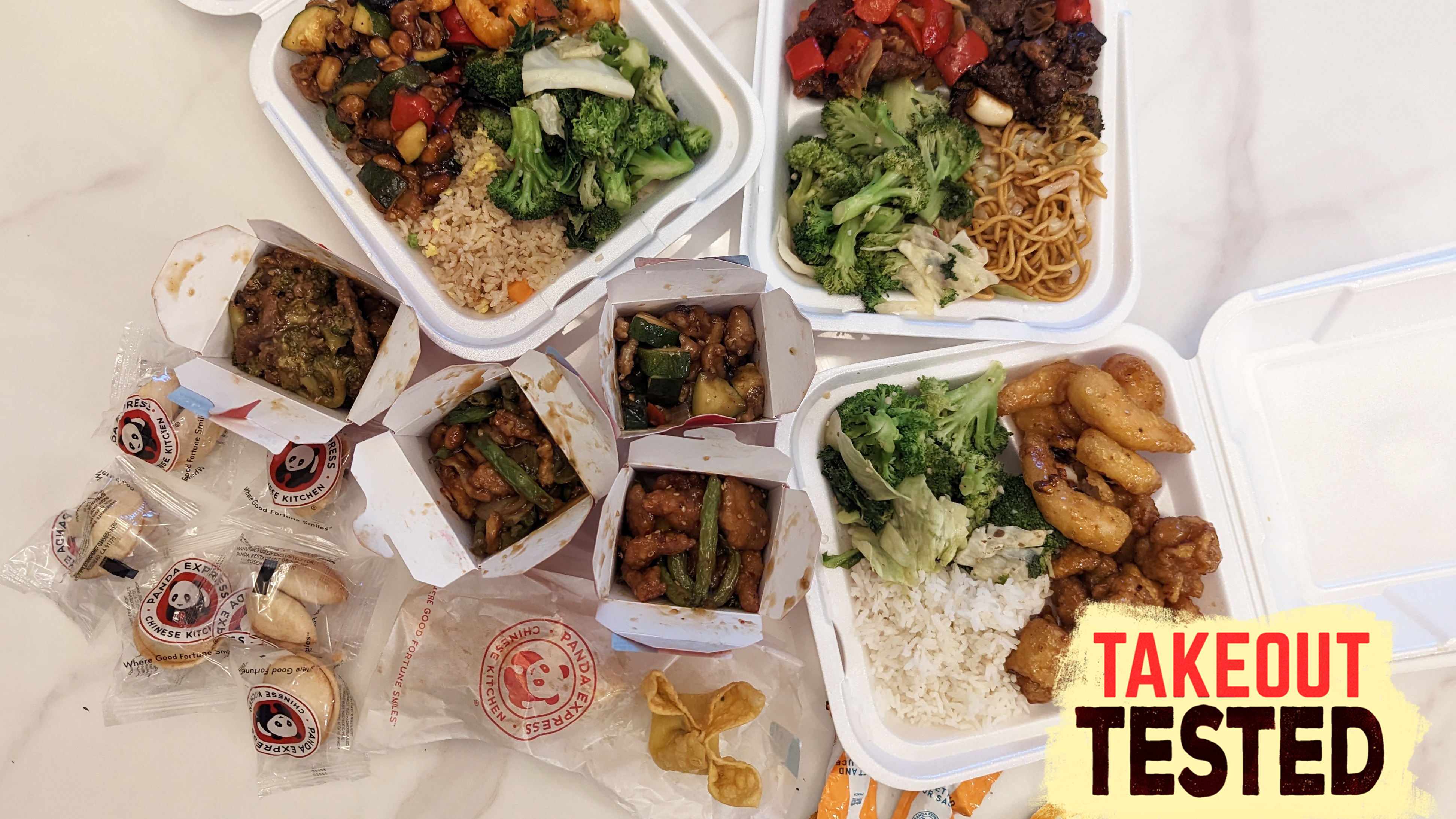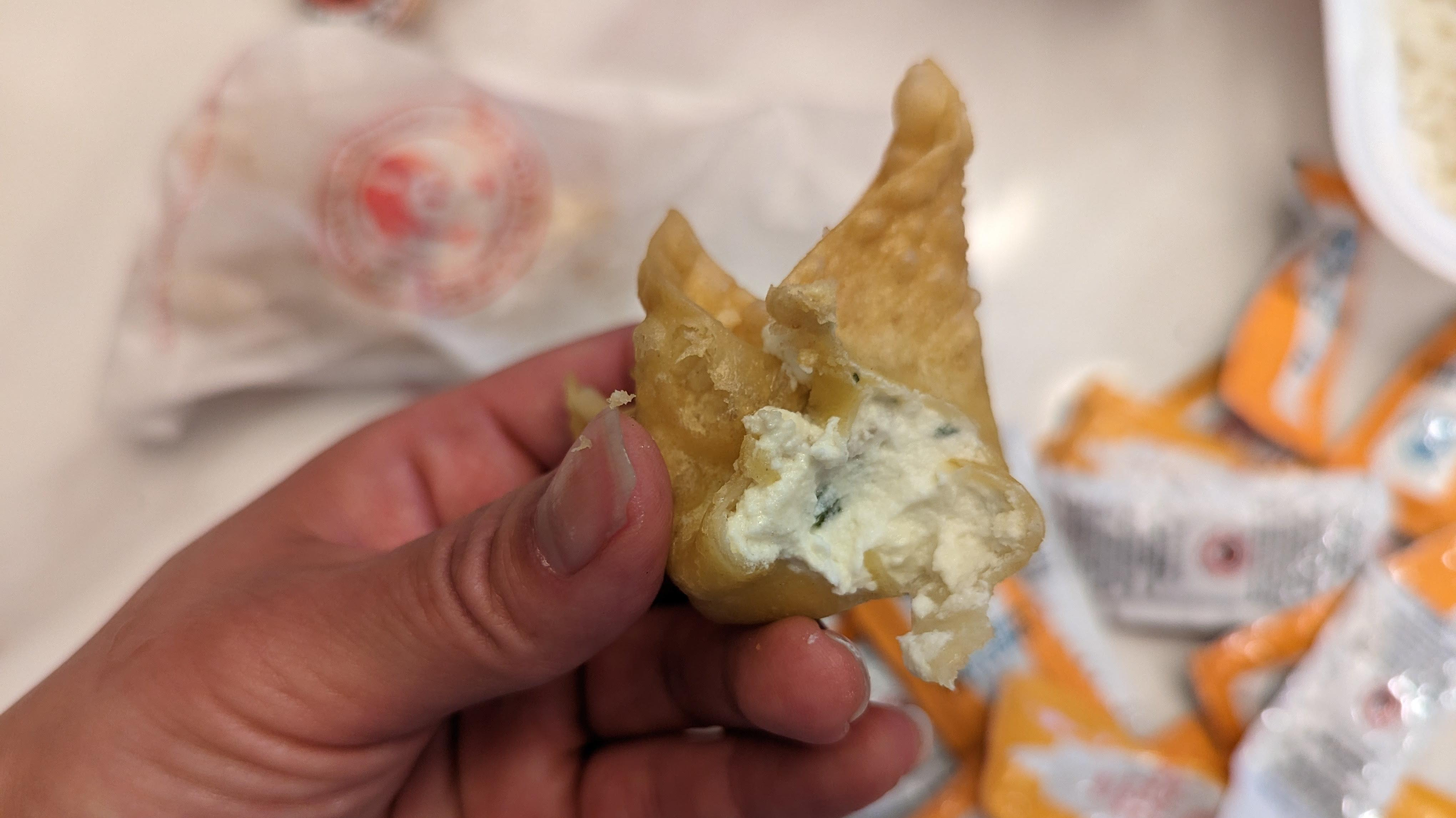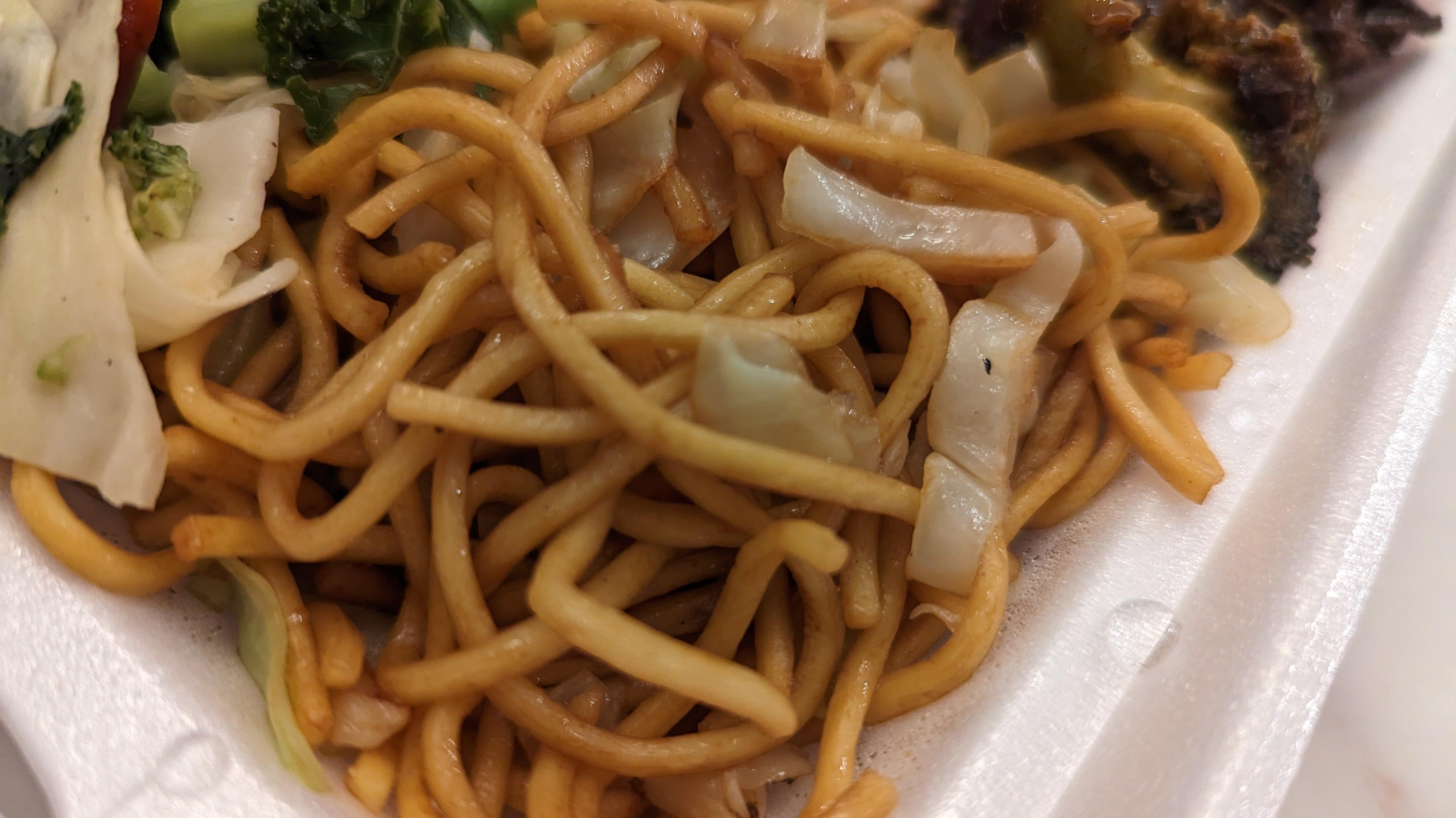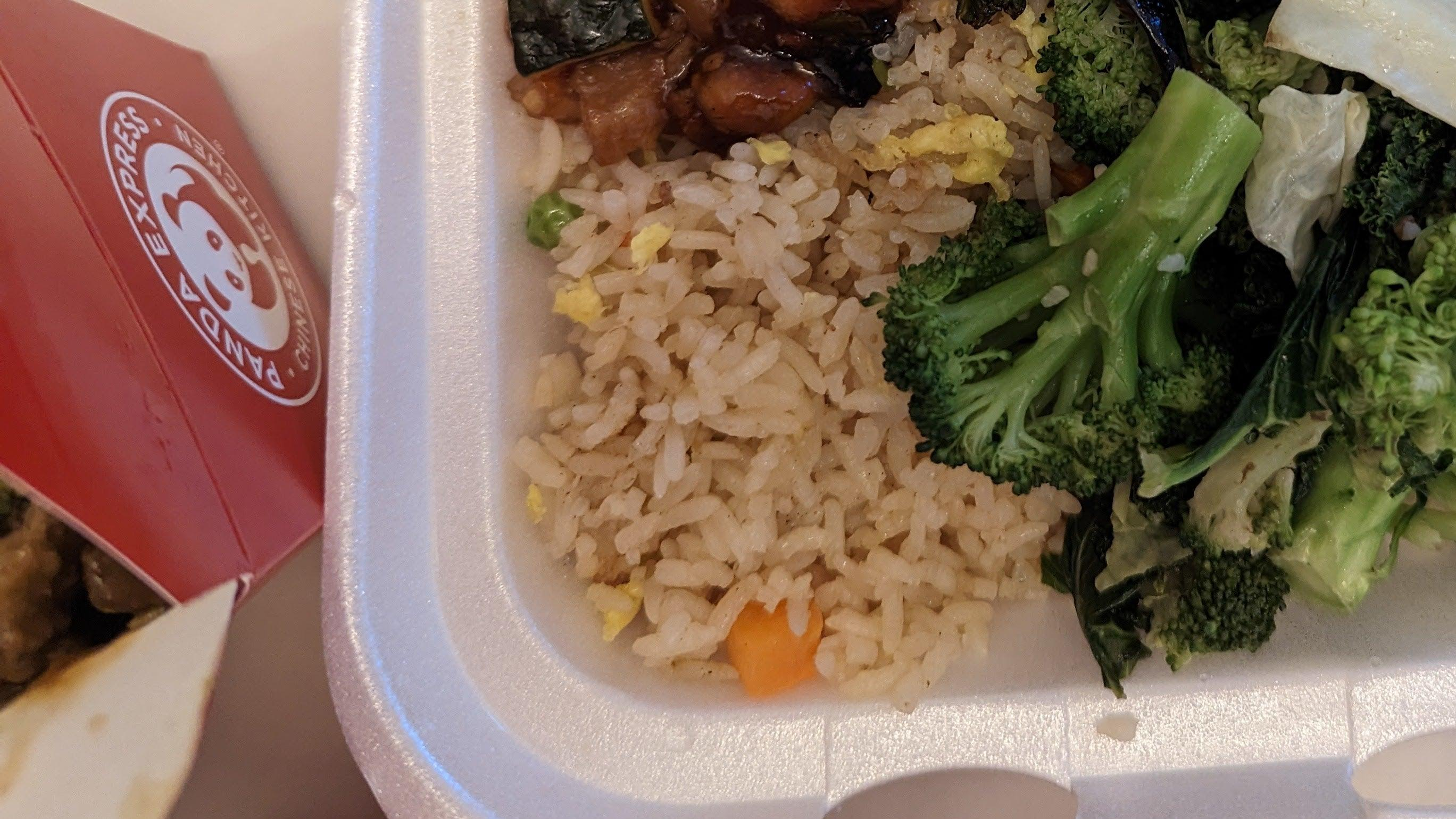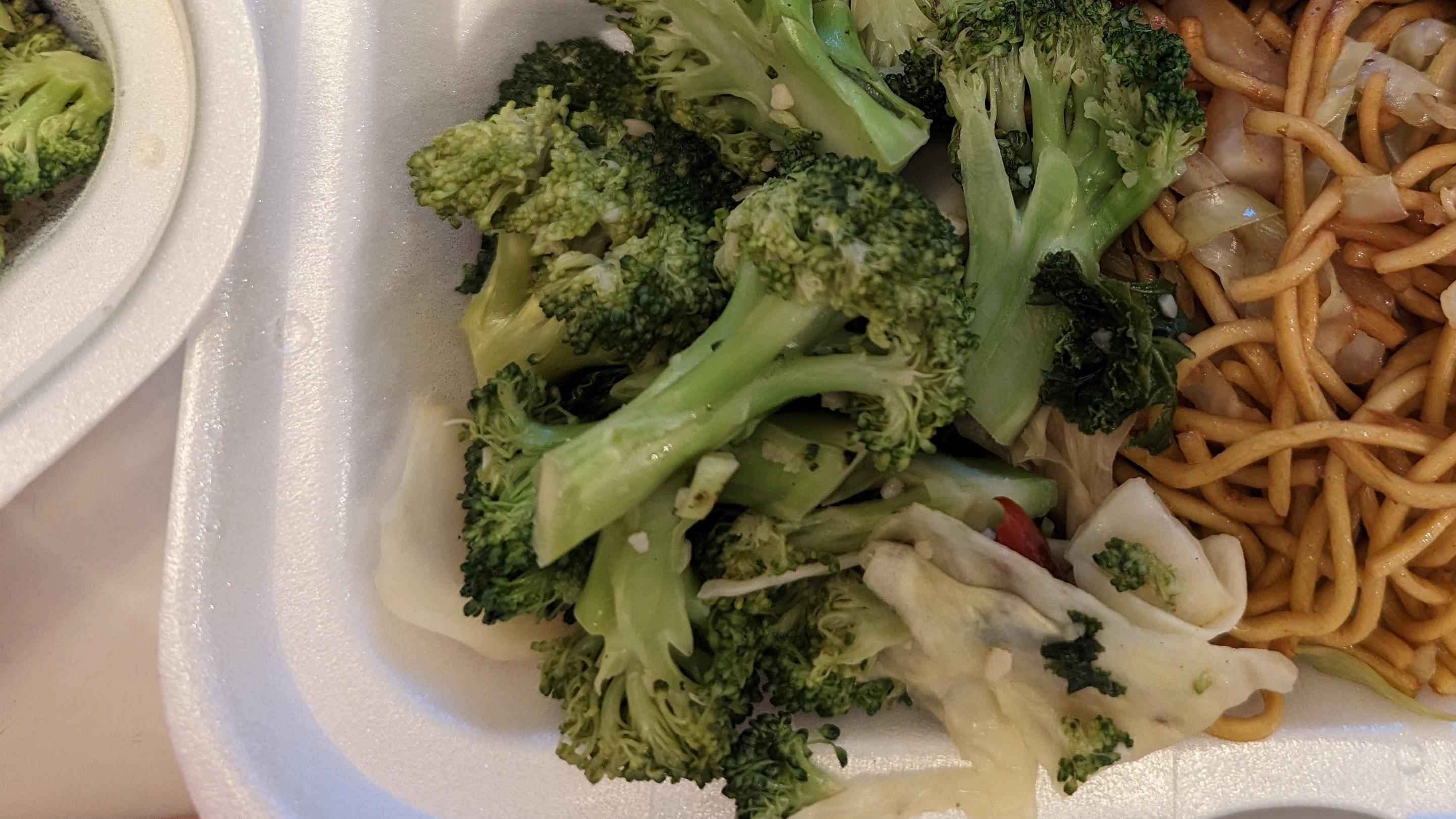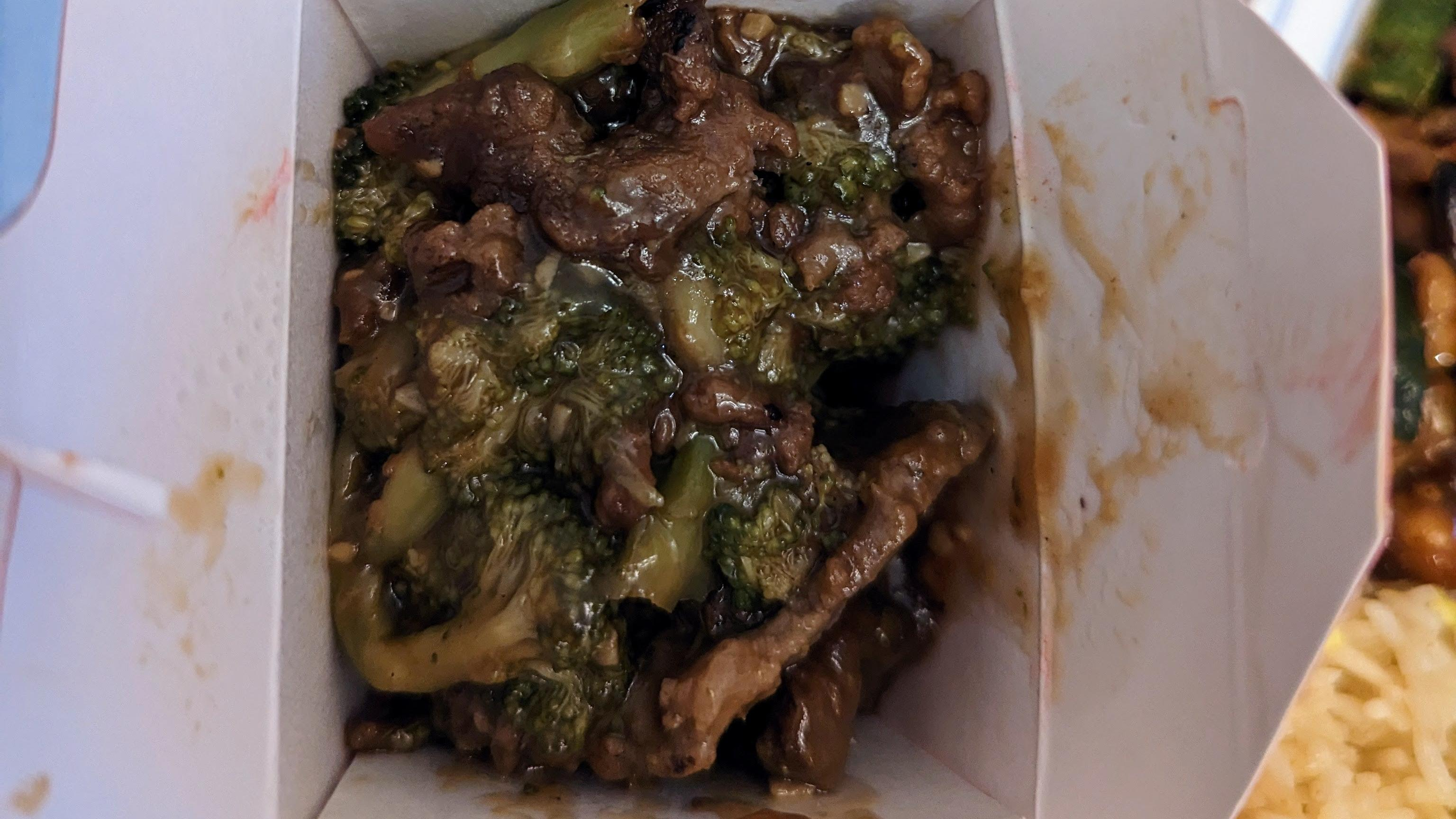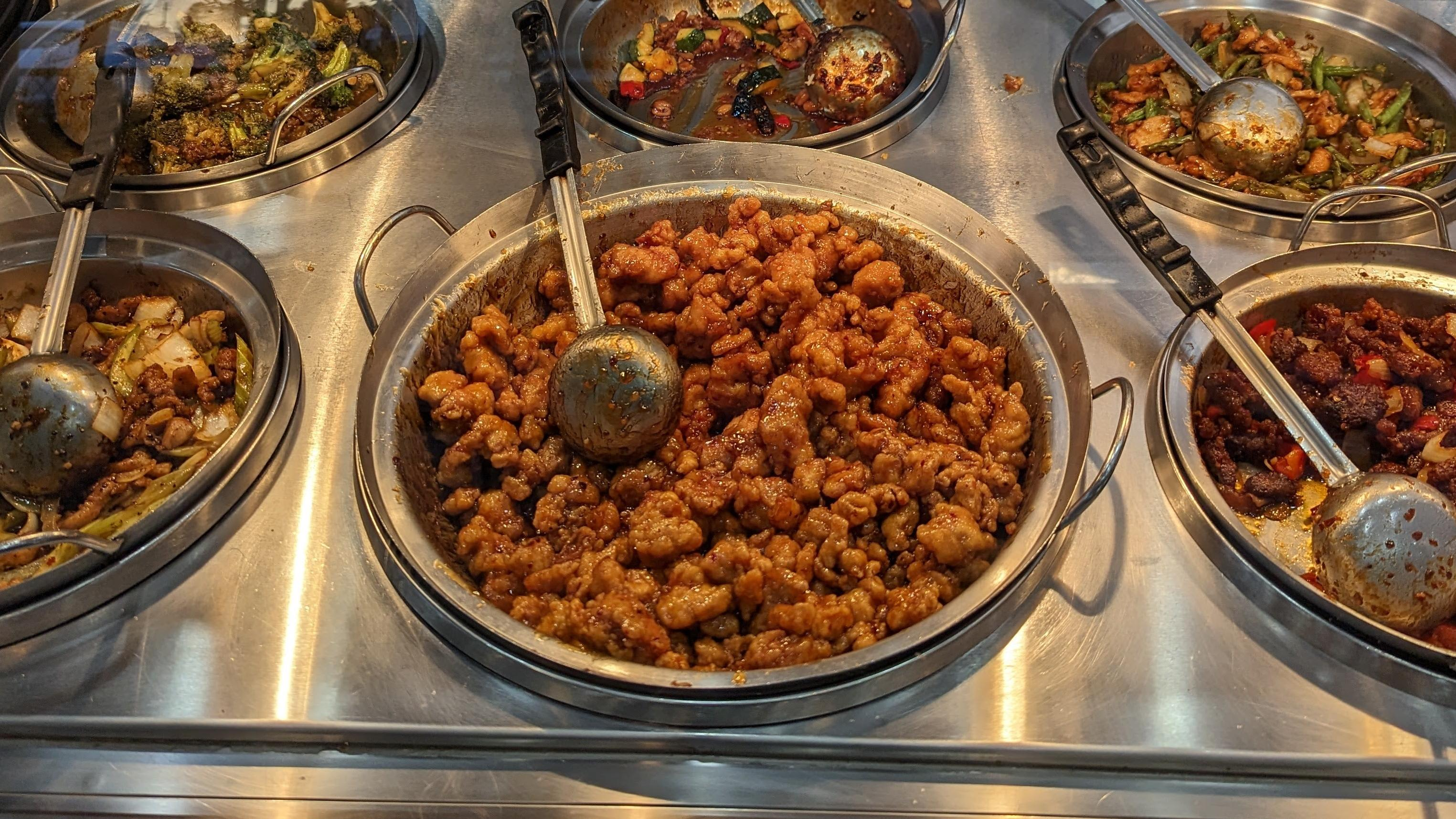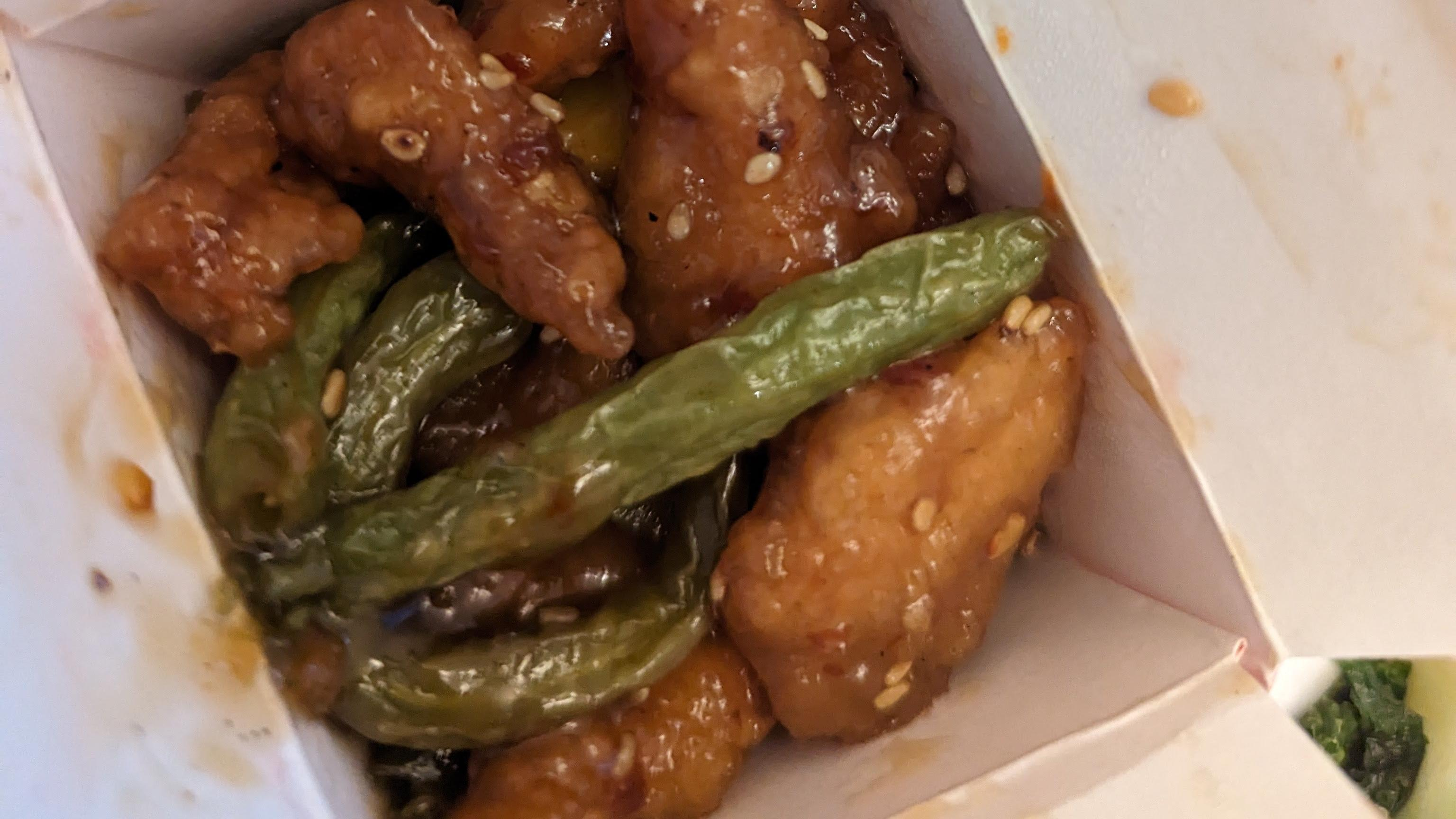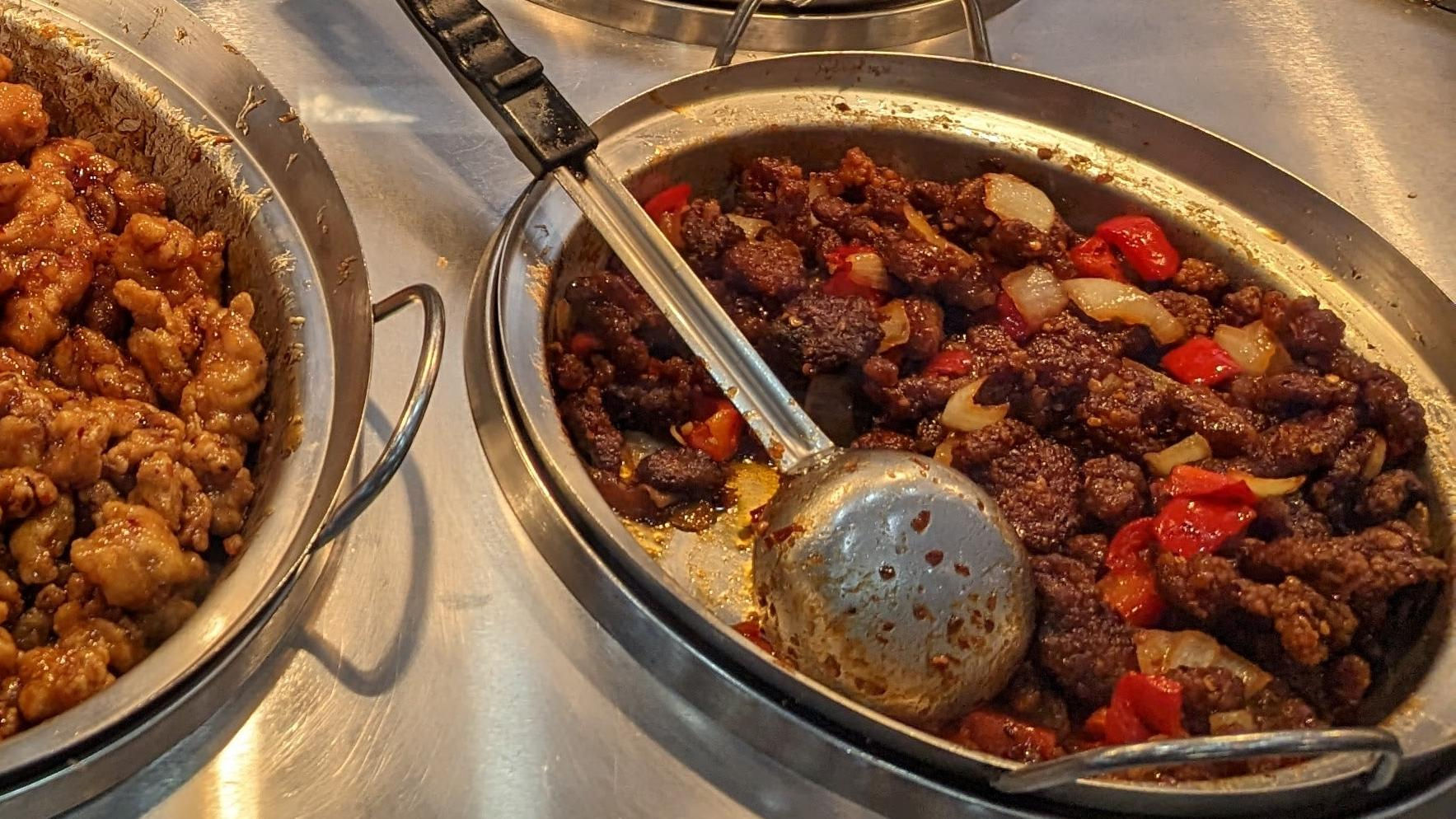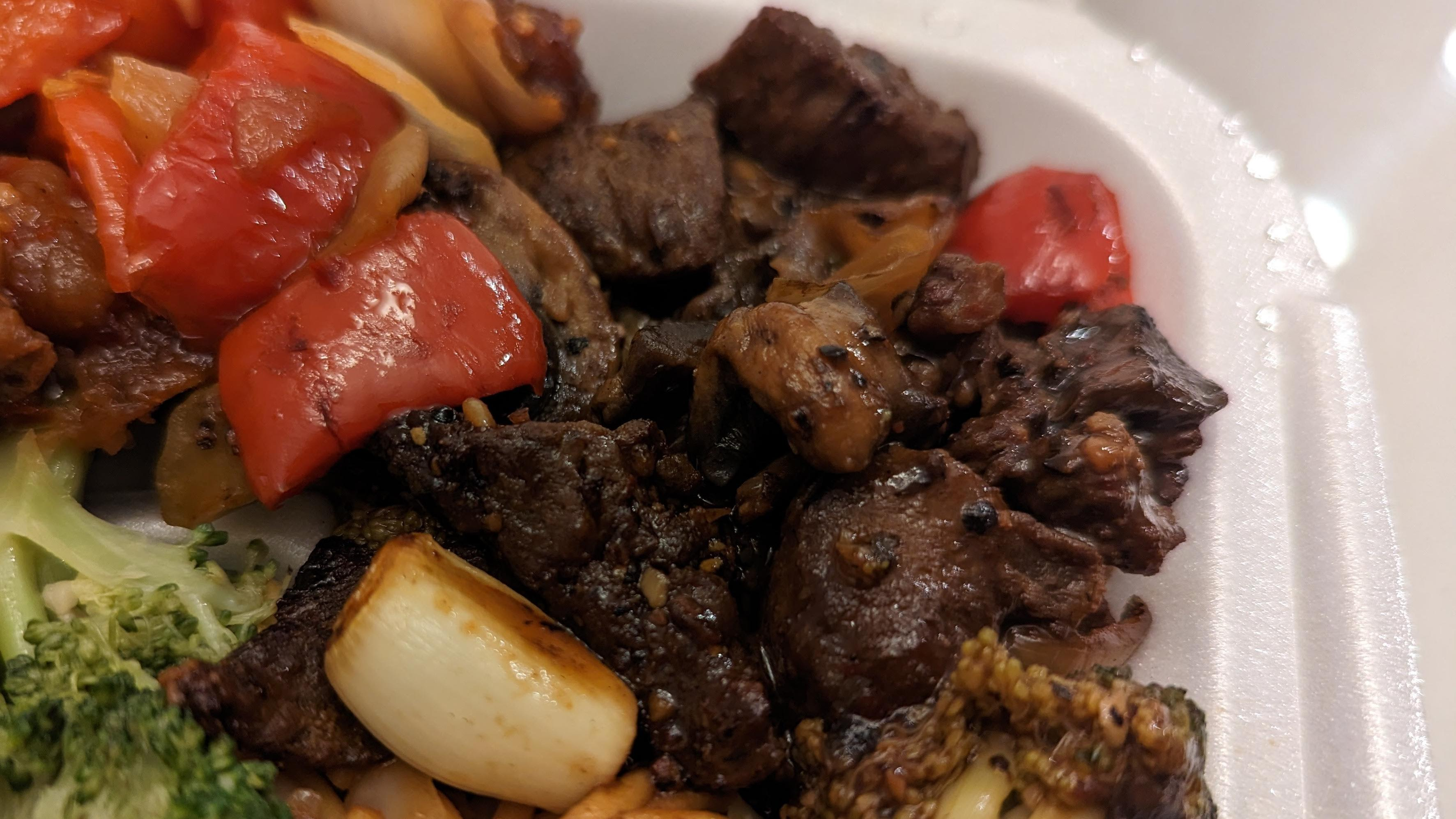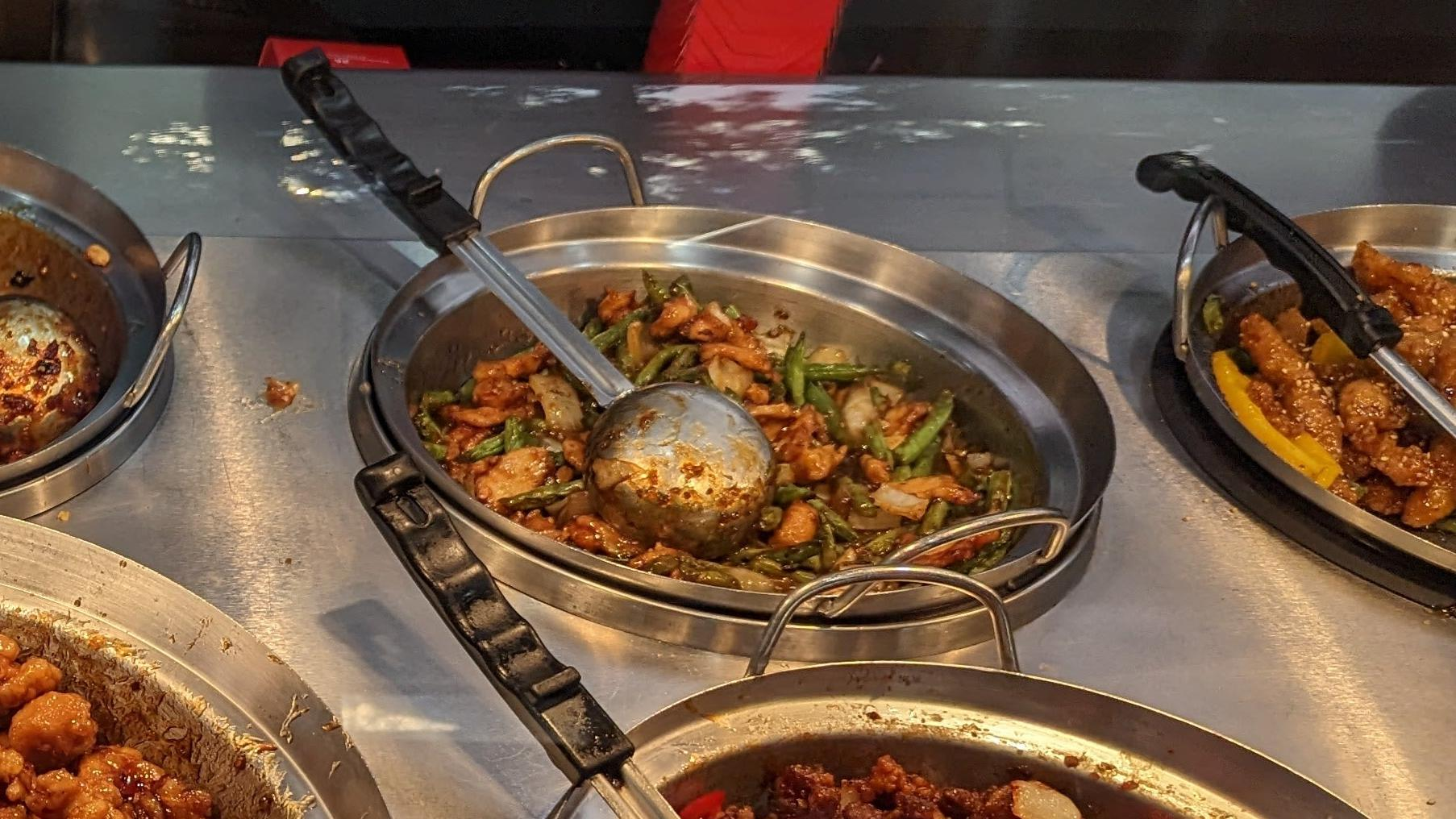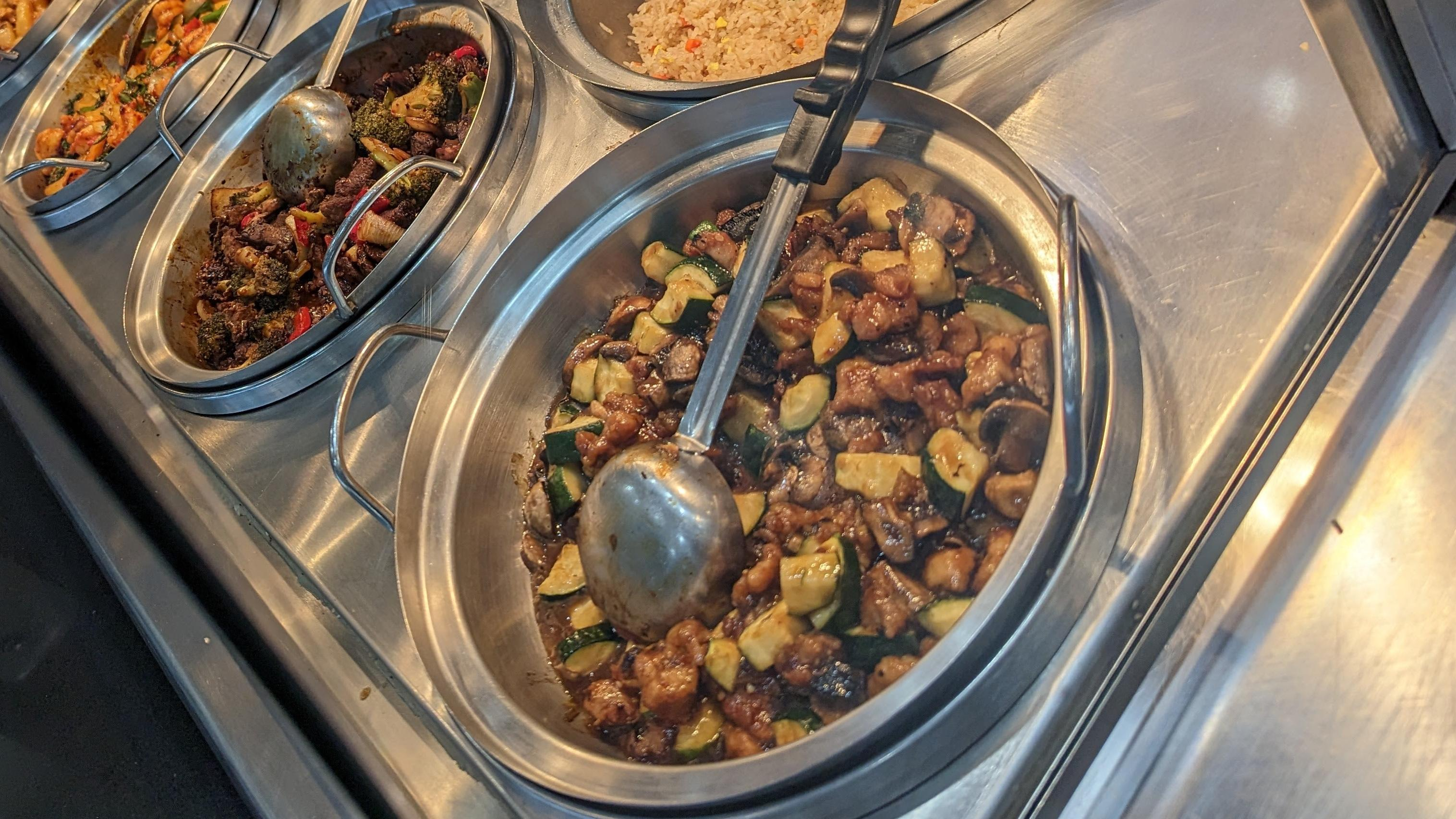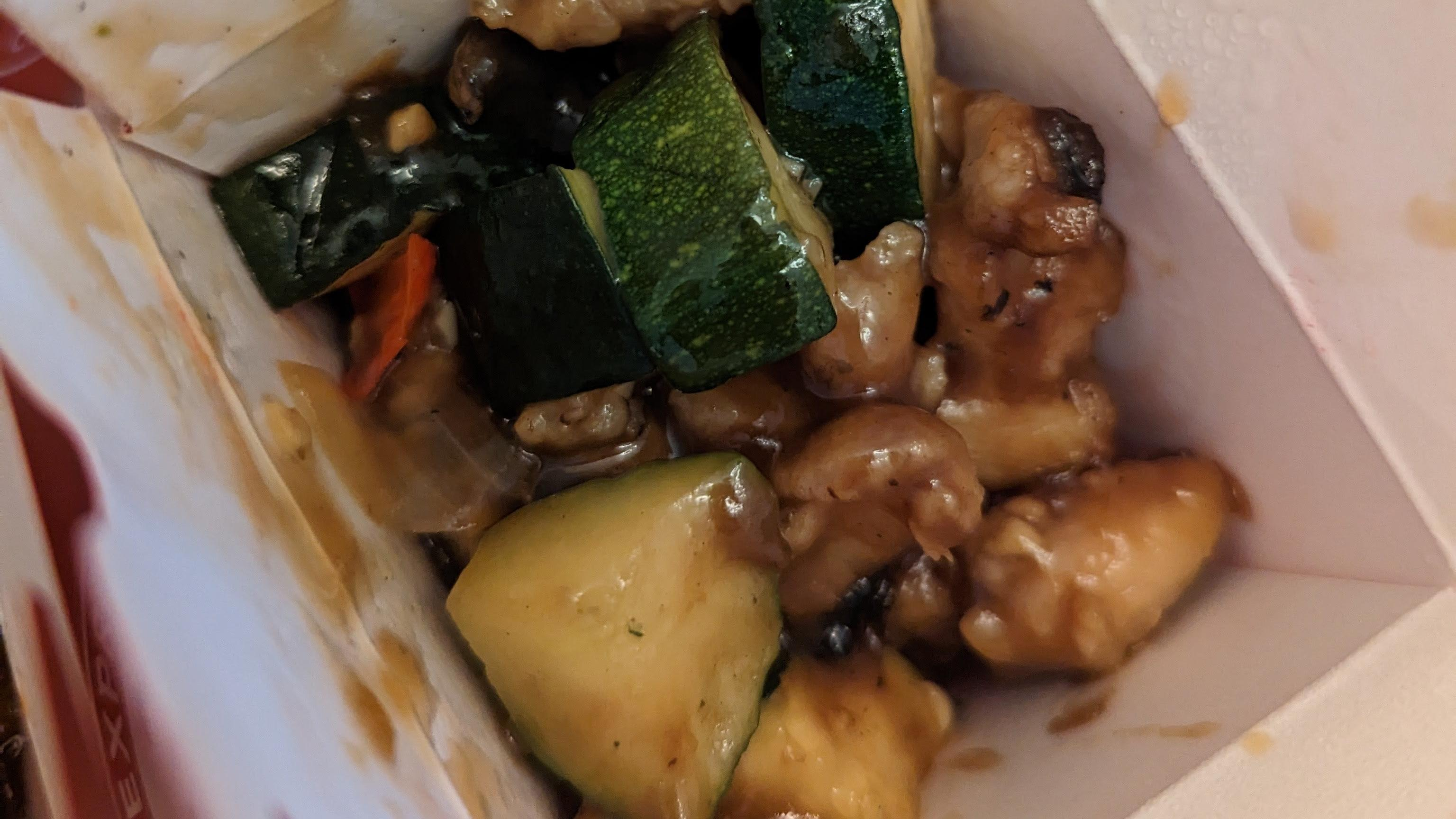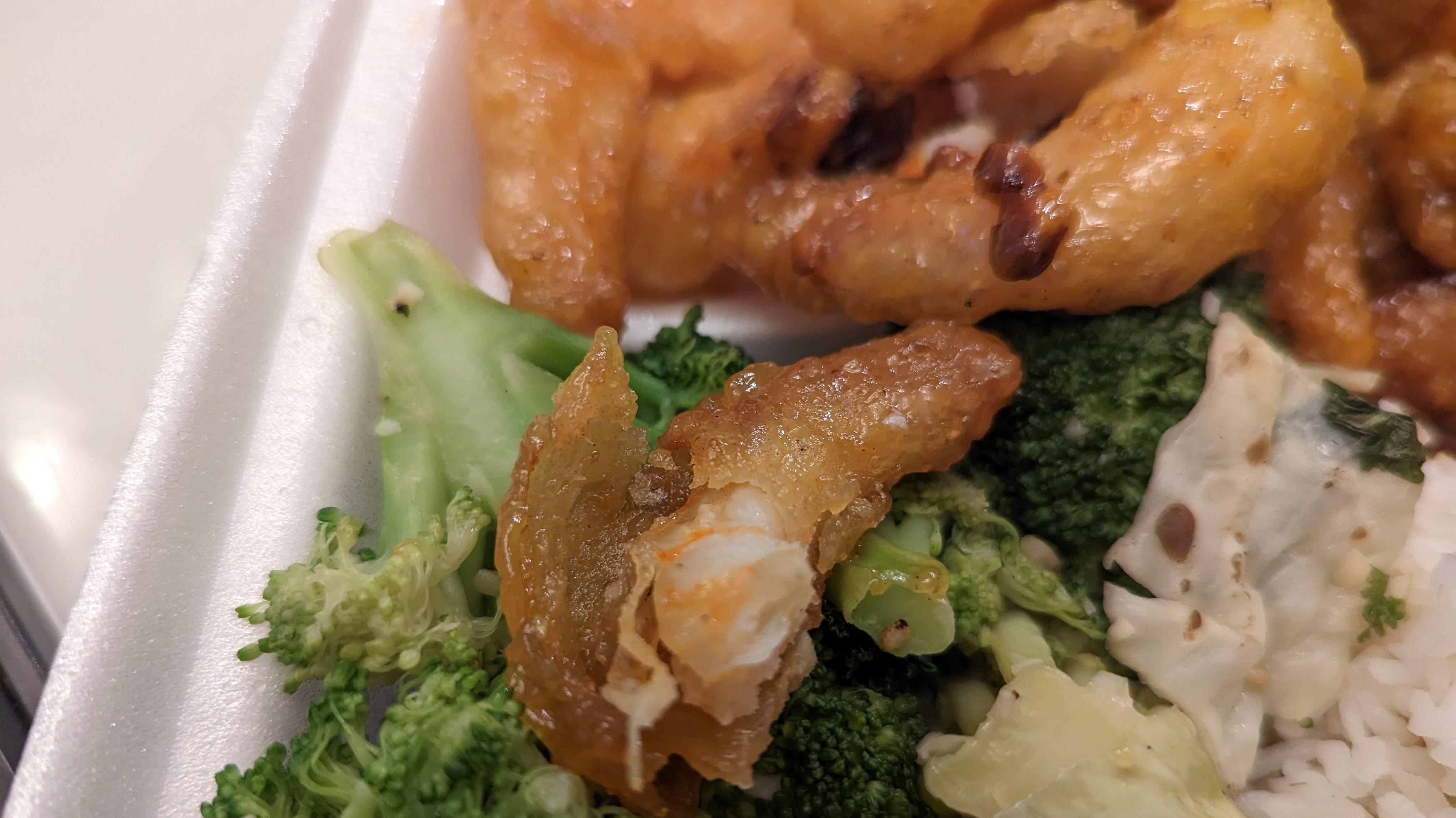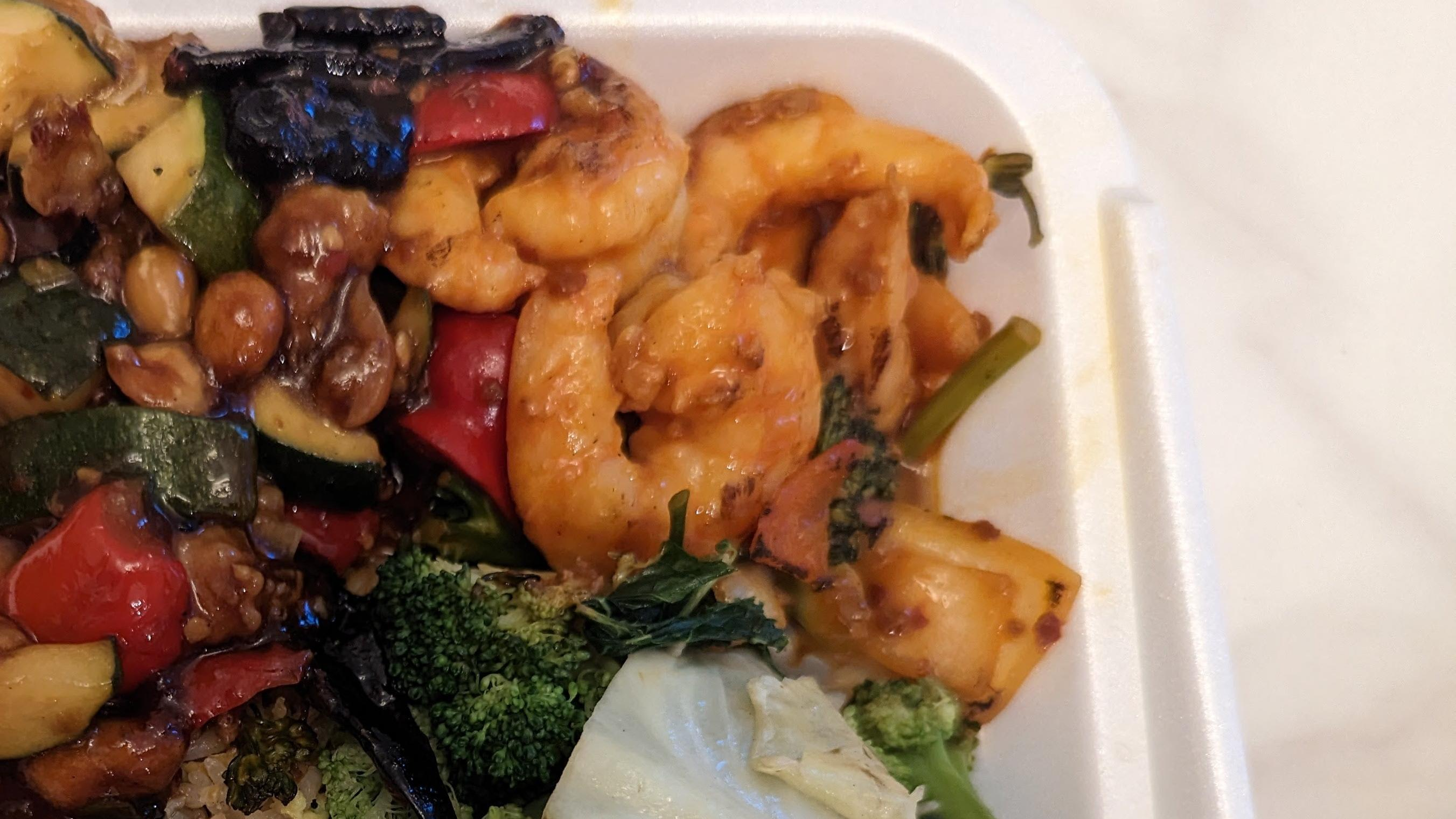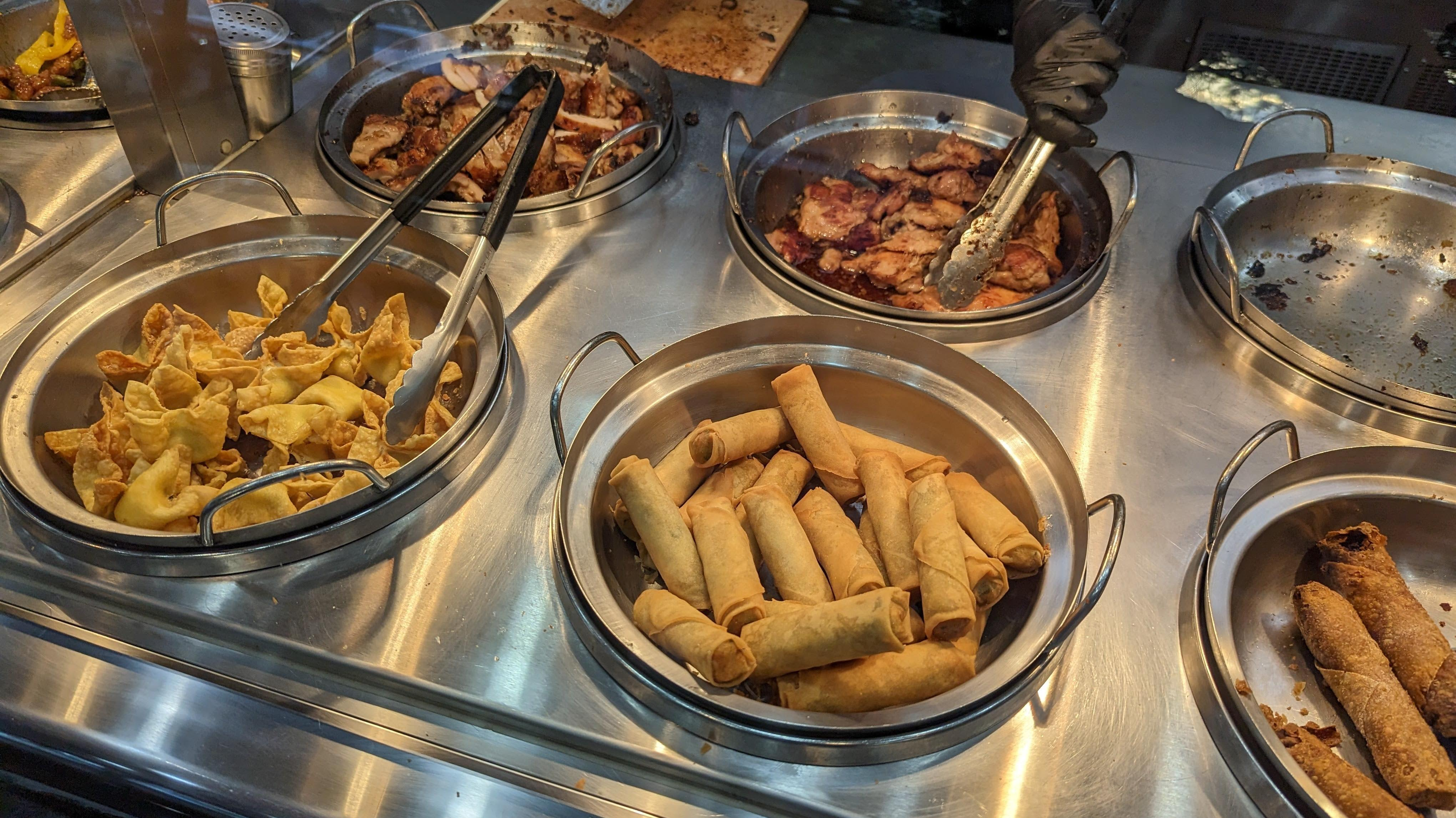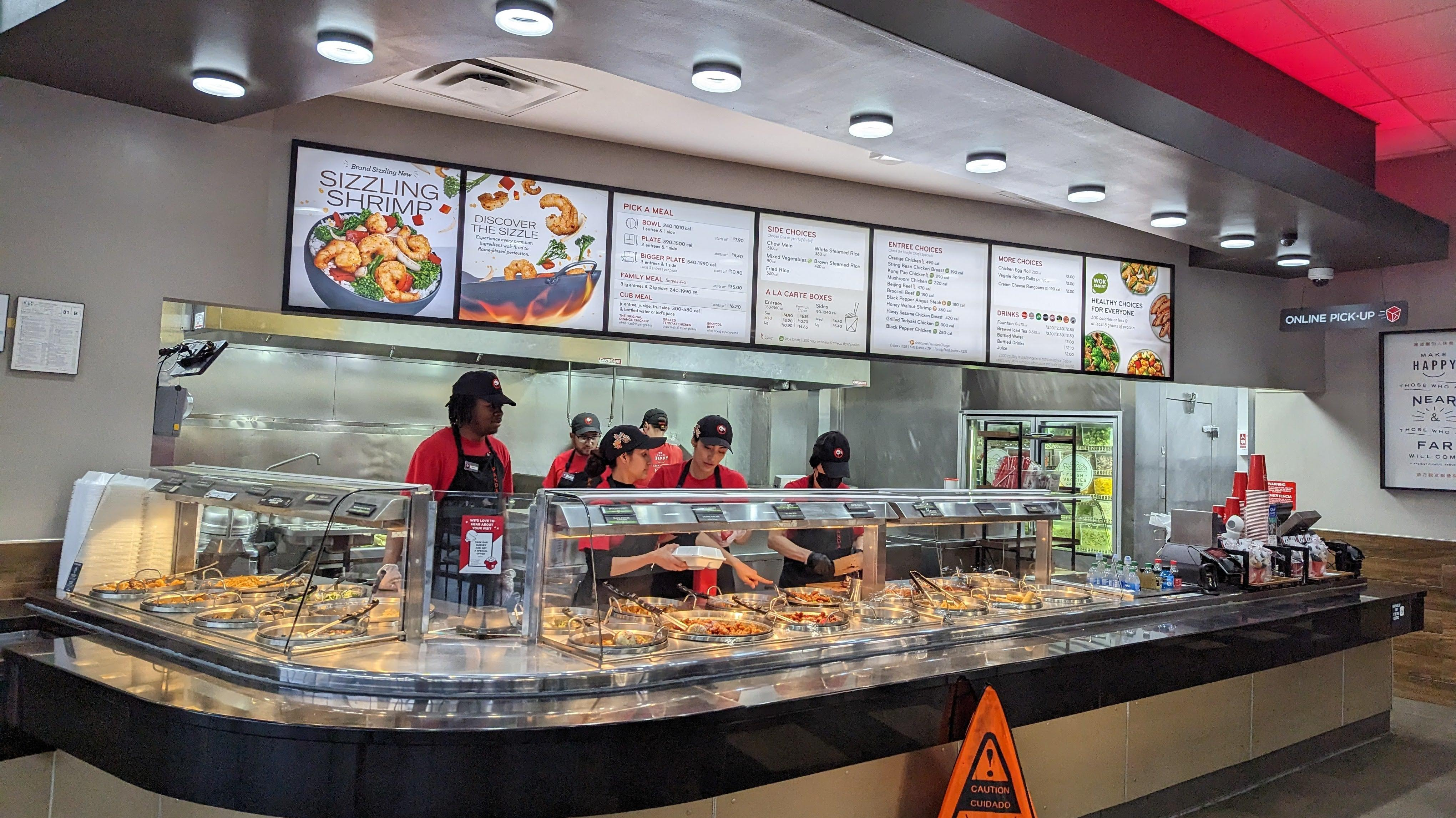How 14 Panda Express Dishes Compare To "Real" Chinese American Takeout
We tasted 14 Panda Express entrees to see how they stack up against traditional Chinese American staples.
American Chinese food catches a lot of flack in both circles. Its authenticity is often disputed, and it's commonly written off as a "guilty pleasure" by those who indulge in it. But the fact is, this food has become its own genre of regional Chinese cuisine and some of its dishes are as American as apple pie. Find yourself a cuisine that can do both.
I was raised on red pork with yellow-dyed fried rice and the deep-fried sugar chicken we call General Tso's. Being that my family operated a restaurant on Long Island, New York, where takeout competition is fierce and standards are high, I was spoiled with the very best American Chinese. And by "spoiled," I mean ruined.
Once I moved away, I was hard-pressed to find dishes like lo mein and boneless ribs that came close to the quality of my dad's. In Atlanta, where I now live, we have a wealth of "authentic" Chinese establishments, but old-school counter-serve takeout is harder to come by. Here to fill in the gap is Panda Express, a California-based, Chinese American family-owned quick service chain. With hundreds of locations nationwide, Panda Express is taking up the torch once held by a network of independent family-owned restaurants. But does the brand do it well? How do its dishes compare to the staples found at traditional American Chinese takeouts?
Panda's spokesfolks assure me that "all of [the] back-of-house associates are trained by the most senior chef, shift leaders, and/or general managers" via online module courses and extensive in-person training. Cool, but I'm still skeptical.
But they went on to say that the master chefs do use the traditional open flame ranges, cooking only small batches at a time in eight-pound woks using the showy tossing technique that captures wok hei, as well as the easier tumble-cooking stir-fry methods. Okay, a few more legitimacy points scored.
Ultimately, the only way to find out if Panda Express can hold a candle to the wok-fired takeout my father, grandfather, and their colleagues all mastered over years of apprenticeship, training, and experience is to go in undercover and order an unreasonable amount of food for one person. Here's how 14 dishes measure up.
Cream Cheese Rangoon
This popular appetizer is a perfect example of non-Chinese Chinese that has become ubiquitous at American Chinese restaurants. (First clue: dairy.) They were actually invented at Trader Vic's, the "Polynesian" restaurant we can also thank for the Mai Tai.
I remember falling in love with these deep-fried pockets of seasoned cream cheese and surimi when my dad started making them by popular request. At best, they're crispy on the outside and hot, tangy, and gooey inside. Panda Express's execution is pretty spot-on: The outer crown is light and crispy, bubbled up from the fryer and softer toward the middle, where the wrapper is kept moist by the scallion cream cheese. However, I definitely felt the omission of krab, onion, and the other flavors my dad used to layer in.
Verdict: 6/10. Appearance and preparation were correct but the flavors ran kind of flat.
Chow Mein/Lo Mein
First, let me preface that chow mein means something different to West Coasters and East Coasters. Technically, chow mein means fried noodles, which is why in the Northeast, it's a saucy stir-fry dish meant to be draped over a bed of crispy fried noodles. On the other hand, lo mein has noodles tossed with sauce and its accompanying ingredients. Both are made with egg and wheat noodles, but the kind and preparation of the noodles is different in each.
The Panda Express version is a hybrid, featuring bouncy egg noodles that taste just greasy enough to make me question if they were made from dried, fried noodles (a la ramen) or if the oil they might have been cooked or stored in just permeated through the dough. Either way, the dish was actually rather flavorful, despite minimal sauce, and the onions, celery, and cabbage added sweetness, aroma, and texture I definitely wasn't mad at. As a side that doesn't cost extra, I was happy to spring for these springy noods.
Verdict: 8/10. Although these noodles didn't strictly meet the definition of either lo mein or chow mein, I appreciate that American Chinese is always hybridizing and found these to be pretty objectively tasty.
Fried Rice
To me, Chinese takeout fried rice means red pork, blistered onions, and yellow rice. To Panda Express, it's something considerably more muted: steamed white rice, which gets its yellow from eggs, plus some peas and carrots that lend color and a burst of sweetness. It's supposed to have scallions, but I didn't get any.
Generally, fried rice is supposed to have a lot of concentrated flavor, enough to be a meal in itself, but Panda's version is only lightly and unevenly seasoned. Each bite starts bland and ends salty. Perhaps it's designed to play against the heavier entrees, but on its own, I found it utterly unremarkable.
Verdict: 5/10. To be fair, this is closer to "authentic" Chinese fried rice, which tends to be lighter in color and flavor. But we're comparing it against American Chinese, which is far bolder.
Supergreens
I love vegetables. I've written multiple love letters to greens and conducted enthusiastic taste tests of salads. Therefore, I cannot emphasize enough how much I appreciate that Panda Express lets you go half carbs/half veggies on your side dish selection, especially since the "side" amounts to half your plate. This is a bonus that you can sometimes get with your mall teriyaki chicken but won't get at any American Chinese takeout, and it's a considerable incentive to choose this chain over another fast food option while on the go.
Panda Express Supergreens feature steamed broccoli, lightly sauteed cabbage, and some kale, nicely seasoned with garlic. The cabbage is crisp, the broccoli is soft, and the kale is only slightly bitter. This is uniquely Panda Express, as kale isn't usually on takeout menus and steamed mixed veggies at mom-and-pop joints are usually full orders of broccoli, carrots, bok choy, and sometimes mushrooms and water chestnuts (and not available as a 1:1 rice swap).
Verdict: 9/10. I'm so happy it exists as an option that I only took off a single point for the fact that it isn't technically "authentic" American Chinese and only gently seasoned.
Broccoli Beef
The "X-and-broccoli" entree is quintessential to American Chinese and my litmus test for any takeout, because its brown sauce is the foundational sauce upon which nearly everything else on the menu is built. The tenderness of the meat is also a mark of proper velveting. Unfortunately, on this front, Panda Express failed.
I've definitely had better Beef and Broccoli at Panda before, most recently at an airport. In that case, it clearly hadn't spent as much time sitting out as this batch did; the broccoli was a brighter green and the sauce was thinner. But on this visit, it was terribly overcooked and looked it: a sad brown mush with broccoli that had completely fallen apart and sauce so thick that it was like a paste. There was an embarrassing amount of cornstarch in what was mostly oyster sauce, and it was super salty. This diluted with some reheating, but honestly, even mixing it up with plain rice couldn't save it from those Dead Sea levels.
Verdict: 3/10. This made me sad. I ordered this thinking it was going to be my "safe" standby, but it was one of the most disappointing dishes of the bunch. I've had better experiences with this dish, but a lack of consistency overrides it.
Orange Chicken
The Original Orange Chicken© is what Panda Express hangs its hat on. Corporate proudly cites its inspo as chenpi niurou (tangerine peel beef), which is typically "marinated, deep-fried, then wok-cooked with dried chilis, Sichuan pepper, and tangerine peel." Panda has swapped in bird for beef and "an element of sweet and sour."
My first impression of this dish was breading. A lot of breading. So much that most of the smaller pieces don't even have meat inside, and those that did contained dark meat cuts a bit on the chewy side. The upside is that the bites are bigger than the chicken in some of Panda's other dishes. Here, they're draped in a sweet sauce that's only slightly spicy—you get a nice hit of the chili, but that dissipates fast. The citrus flavor is subtle, unlike the breading. On the last bite, I got a slightly sour aftertaste, like orange pith, so points for tasting the ingredient, I guess?
Verdict: 6/10. On the whole, this struck me as the closest to General Tso's you could get, since its shortcomings are shared by that famous, syrupy, very American dish. I wouldn't get this again due to the quality of the meat and the quantity of filler, but it's not too dissimilar to takeout—just a lower quality takeout than what I grew up with.
Honey Sesame Chicken
Sesame chicken, part of the same food group and prep style as Orange Chicken and General Tso's, is usually differentiated only by the omission of spiciness and a generous smattering of white sesame seeds across the top. Panda Express adds honey and green beans, both of which are nice change-ups. The sauteed string beans in this worked way better than the florets of steamed broccoli that always get weird after sitting beside that type of sauce, and I could definitely taste a hint of honey. The addition of sweet bell peppers was a nice touch, too. I loved that the bites of deep-fried chicken remained crunchy and that the meat itself was tender white. I just wish there were more of it; the chicken pieces were really tiny and skinny, the thickness of chicken fries, and like the Orange Chicken, it was more than half breading.
Verdict: 8/10. While this isn't true to Chinese takeout Sesame Chicken, it was undoubtedly delicious, and if the chicken pieces were meatier I'd make this a go-to for future Panda Express orders.
Beijing Beef
I wasn't sure what standard takeout dish this was supposed to be, but I was into it. This dish is actually spicy, so that was exciting, and the heat lingered in a lovely fashion. The "sweet-tangy" sauce smacks of the syrupy, complex aged Chinese vinegar used in Peking pork chops—which I always order when I eat out at "real" Chinese restaurants—but with a kick. It's sweet but not overly so, nicely balanced by some acid and the crispness of the bell peppers. The breading used to fry the beef slices also brought that dish to mind, and I liked that even though it was a little mushy from sitting out under heat lamps, it wasn't a thick coating.
Verdict: 8/10. Even though this isn't a "standard" American Chinese menu offering, it's got a lot to offer in terms of both texture and taste.
Angus Black Pepper Steak
At most Chinese takeouts, pepper steak with onions is stir-fried tender crisp in a thick brown sauce. Here, it's a minimally sauced prep that has more similarity to a dry pot. It's in a sauce that's thinner than the other two beef dishes I tried, and I liked that it was secretly spicy; the heat pops up on the back end. I also liked that it came with mushrooms, onions, and broccoli, even though the latter was very soggy.
However, the Angus steak part of this entrée definitely deserves its place in the headline and warrants its "Premium" upcharge. There were big chunks of tender beef, and the iron-rich steak flavor really came through. That actually made it felt very American, a characteristic further emphasized by the big chunks of cracked pepper—like a gastropub's interpretation of "Asian steak stir-fry" as opposed to anything that felt or tasted actually Chinese.
Verdict: 5/10. If you want steak tidbits with some veggies, this is the dish for you. But is this takeout-style pepper steak? No. So while the ingredients, dish, and flavor are good, it gets a middling grade because it's certainly not accurate to what you might expect, which might be disappointing if you had the more typical dish in mind.
String Bean Chicken Breast
According to Panda Express, this dish is inspired by homestyle Hong Kong Chinese cooking, where protein is meant to support a mainly vegetable-forward dish. Perhaps I shouldn't have been as surprised, then, that the chicken pieces were tiny, just shy of being minced. Privately owned takeouts tend to use the same generous flat cuts of white meat chicken for all of their stir-fry, so this is me being spoiled by American Chinese again, subjectively speaking.
Objectively, though, this was a letdown. There wasn't much dimension to this extremely salty sauce. I could see the black bean bits, but couldn't taste them. The green beans were mushy, but most unforgivably, the sauce was thick, gloopy, and congealed. The onion didn't help with the overall sliminess; it just contributed to it. And for some reason, it reminded me of Thanksgiving flavors, like soggy green beans with unplaceable gravy.
Verdict: 1/10. I feel like, as with the Beef Broccoli, Panda Express has done this dish better another time or two before. But based on this test alone, this was a letdown in every way.
Chicken Mushrooms
This was a weird one for me. Every time I've had it from a mom-and-pop takeout, it's been just chicken and mushrooms swimming in a sea of brown sauce—a fairly nondescript item. But at Panda Express, it actually has more character. Zucchini is added to this version, which came through fresh, crisp, and vegetal, an excellent companion to the earthy white mushroom flavor that comes clearly through the oyster-sauce-heavy gravy. However, the curse of the overly thick, overly salty sauce continues here, with so much thickener you can actually taste it.
Reheating helps thin it out a bit, but it's a step you shouldn't have to take. And where Panda gained points for enhancing this takeout classic with zucchini, it loses an equal amount for using breaded dark meat. Dark meat makes sense, since it's meant to be earthy. But why is it breaded? This added a confusing textural element and even more filler to a sauce already gloopy with too much.
Verdict: 3/5. It's a good thing Panda made an improvement on what's normally expected, because the expected elements fell short.
Kung Pao Chicken
I was relieved to get back on track with the Kung Pao Chicken. This one's a unicorn in that it's a "real" Chinese dish—a specialty of Chengdu, the capital of Sichuan—and one of a handful of American Chinese restaurant menu offerings that will actually appear in a "real" Chinese restaurant. It's typically made with uniformly chopped squares of tender-crisp vegetables like bell peppers and celery, bite-sized chicken, dried chilis, and little peanuts mixed into a glossy sauce with ginger and garlic.
Panda Express nails the visual excitement by adding a splash of green zucchini to the red peppers. The sauce is thick, but this time, appropriately so, and the heat of the chili sits on your tongue. The roasted peanuts are mixed in, which puts them on the softer side as they absorb the sauce, but they're unsalted so they add their toasty flavor and a different texture without messing with the rest of the dish.
Verdict: 9/10. This is as accurate as Panda Express gets. It's not my favorite dish in the world, but it's damn near spot-on for what you expect from an American Chinese restaurant and pretty close to what a Chinese Chinese restaurant might serve.
Honey Walnut Shrimp
There are a few variations of Honey Walnut Shrimp. My dad battered his jumbo shrimp with a tight-crumbed, airy batter before placing it on a sweet garlic sauce with vegetables and finally topping it all with walnuts he'd roast in-house with real honey. But a more traditional prep is actually to coat the shrimp in a creamy mayonnaise-based white sauce on a bed of steamed broccoli and then scattering glazed walnuts on top of it all.
Panda Express takes its cue from the "authentic" Hong Kong/Cantonese banquet-style recipe, where you can clearly taste the mayo (which isn't a bad thing!) in the sweet-skewing sauce. However, that's kind of where Panda leaves it. This is a medium shrimp encased in a thick, kind of tough batter that's supposed to be a tempura-style but closer to a sweet and sour. It was dry, which makes sense since this kind of dish doesn't really keep well. You have to eat it fresh.
Verdict: 5/10. Close enough to the real deal, but not something to write home about. This is, again, where too much filler takes away from the actual taste experience.
Sizzling Shrimp
This new limited-edition dish was released for Lent but will be available nationwide until June 20. I tried this for the fact that it's new, it's limited, and it had clearly larger shrimp and was sauteed. Another intriguing selling point was that it's in a tomato-based sauce, which made me wonder if it's Panda's healthier take on another retro American Chinese dish, Butterfly Shrimp with Bacon (it's not). Also, I'm a sucker for broccoli all day, every day, and broccolini was a lure I couldn't resist.
The baby broccoli lived up to its promise, tender and sweet, and the hit of heat at the tail end of the sauce complemented it like Calabrian chili oil on roasted broccolini. I could clearly taste the ginger and garlic in the sauce, and the pepper and onion formed a natural pairing. I personally thought it was pretty tasty, but the ketchup-y undertones in a stir-fry might be off-putting for some.
Verdict: 7/10. I can't give it any points for being similar to anything you'd get from an American Chinese restaurant, but trust me when I say sweet tomato-laced sauces (like tomato eggs) are not uncommon to homestyle Chinese cuisine.
Value
We can't talk about Chinese food without talking about bang-for-your-buck value. In Fuzhouhua, we have a word for that, and it's used so much that it's one of the first my boyfriend and sister's fiance picked up.
By Fuzhounese restaurateur standards—a group known to fill containers up to overflowing—Panda Express is a terrible value. By the standards of Mandarin-speaking restaurateurs, who are less likely to undercut their competition through loss leaders, Panda's value is not egregious, but still falls short.
The small portions at Panda Express are tiny—they come in half pint containers that aren't even topped off to the line, which feels especially stingy for around $5 a serving. (For reference, that's the one-cup portion typically reserved for the rice you get with single items.) The medium is everyone else's small, and in the $8 range. The large portions are around $11, and they don't come with rice when you order a la carte.
On the other hand, two entrées and a double-sized side is only $9.40, and being able to get a dinner portion meal for that price is hard these days. And there's no one else out there offering such a wealth of vegetables on demand with instant gratification; mere peppers, onions, and beans as a veggie entrée is a joke and salads only start at that price. And other fast casual joints aren't giving you fortune cookies, either.
Verdict: 5/10. It's not a better value than your local Chinese takeout, for sure, but it's still better than what you'll get at any other fast-casual chain.
Final Judgment
Panda Express' Overall Rating: 6/10, according to math. According to feelings, I think that's fair.
Is Panda Express "real" "fake" (e.g. American) Chinese food? Sometimes yes, sometimes no. Is it as good as something made fresh to order, cooked just for you by a chef trained via trial by fire? Of course not. But until my next visit back to New York, if I need some interesting veggies quick and don't feel like a salad, Panda Express will certainly fit the bill.
